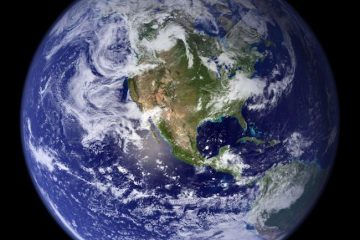Table of Contents
- Exploring the Foundations of the Gaia Hypothesis
- Interconnected Systems: How Gaia Shapes Our Environment
- Delving into Gaias Influence on Ecological Balance
- The Controversies and Critiques Surrounding the Gaia Hypothesis
- Applying Gaia Theory: Practical Implications for Modern Environmentalism
- Q&A
- Wrapping Up
Exploring the Foundations of the Gaia Hypothesis
The Gaia Hypothesis presents an intriguing view of Earth as a living, self-regulating organism where the biosphere, atmosphere, oceans, and soil interact in ways that maintain life-sustaining conditions. Conceived by scientist James Lovelock and popularized alongside microbiologist Lynn Margulis, this theory delves into how these components evolve together harmoniously. The concept suggests an integrative system where life influences its environment at large scales, promoting balance and homeostasis. This notion challenged traditional viewpoints, emphasizing the interconnectedness inherent in Earth’s ecosystems.
Key Elements of the Gaia Hypothesis include:
- Biosphere Feedback: The idea that biological processes contribute to the regulation of the Earth’s environment.
- Homeostatic Systems: Mechanisms by which the earth maintains conditions conducive to life, akin to a living organism maintaining its internal stability.
- Co-evolution: The mutual evolutionary influence between biotic and abiotic components of Earth.
While the hypothesis remains a subject of debate, its implications inspired multidisciplinary research, bridging fields like climatology, ecology, and geology. Critics question the extent of biotic regulation and highlight gaps in empirical data, yet the hypothesis fosters critical discussions about Earth’s systemic nature. Consider the impact of global processes like photosynthesis or oceanic currents that span the planet yet are intricately linked to life. The Gaia Hypothesis pushes us to ponder Earth not just as a provider of resources but as a living system with complex interdependencies.
| Element | Role in Gaia Hypothesis |
|---|---|
| Biosphere | Regulates atmospheric composition through biological activity |
| Atmosphere | Maintains temperature and climate stability |
| Oceans | Absorb CO2 and moderate Earth’s climate |

Interconnected Systems: How Gaia Shapes Our Environment
The Gaia hypothesis presents a revolutionary perspective on the intricate web of life, emphasizing the mutual dependency and collaborative adaptation among Earth’s systems. Each component, from the smallest microbe to the largest geological structure, acts as a cog in a vast machinery that balances planetary conditions. The theory suggests that life’s processes continuously interact with the physical surroundings to maintain optimum conditions, much like a homeostatic system. This interaction is not just beneficial but essential, ensuring conditions remain suitable for life to thrive over eons.
Consider the carbon cycle, where forests act as lungs for the planet, exchanging carbon dioxide for oxygen. Through photosynthesis, plants not only contribute to atmospheric balance but also influence geological processes. Decayed plant matter turns into nutrient-rich soil, fostering further life and modulating climate patterns. This relationship highlights a dynamic feedback loop, where each change in climate or biosphere can have a reciprocal effect, underscoring the interconnectedness that Gaia posits.
- Forests as carbon sinks
- Role of oceans in climate regulation
- Microorganisms in nutrient cycles
In a broader scope, oceans operate as climate regulators, absorbing and redistributing heat globally, thus impacting weather patterns across continents. Furthermore, the Gaia hypothesis articulates the role of microorganisms, such as algae, which contribute to cloud formation and weather regulation. This intertwining of biological and physical systems showcases a resilient network capable of responding to changes, whether sudden or gradual. By understanding this symbiotic relationship, humanity can better appreciate the complexity and fragility of Earth’s systems, inspiring more thoughtful, holistic approaches to environmental stewardship.

Delving into Gaias Influence on Ecological Balance
At the heart of the Gaia Hypothesis is the notion that the Earth functions as a self-regulating system, where the biosphere, atmosphere, oceans, and soil exhibit a synergy that sustains life. This concept underscores how living organisms and their inorganic surroundings collaborate dynamically to maintain climatic and biochemical homeostasis. Consider how vegetation, for instance, contributes to atmospheric balance by releasing oxygen through photosynthesis, thus supporting aerobic life forms. Similarly, the vast oceanic phytoplankton populations play a crucial role by sequestering carbon dioxide, mitigating climatic shifts, and fostering marine ecosystems. This grand orchestration reflects the intricate interplay between life and its planetary environment.
Understanding Gaia’s influence on ecological balance invites us to appreciate the feedback loops that perpetuate environmental stability. These feedback mechanisms can be observed in phenomena such as nutrient cycling and energy flow within ecosystems. Key components include:
- The carbon cycle, where carbon is exchanged between the atmosphere, hydrosphere, lithosphere, and biosphere.
- The nitrogen cycle, which involves bacteria vital in the conversion of atmospheric nitrogen into forms usable by living organisms.
- Thermoregulation mechanisms like Earth’s albedo effect, affecting climate patterns and surface temperatures.
To better grasp these processes, consider the table below, illustrating the synergetic interactions:
| Process | Component | Impact |
|---|---|---|
| Photosynthesis | Plants | Increases Oxygen Levels |
| Carbon Sequestration | Phytoplankton | Reduces CO2 and Climate Change |
| Nitrogen Fixation | Bacteria | Enhances Soil Fertility |
These interconnections provide a framework for appreciating the delicate balance maintained by natural systems. By acknowledging the Gaia Hypothesis, we open a dialogue about humanity’s role within this framework and the importance of sustaining these natural processes. This awareness is critical for fostering a future where human activities are harmonized with the principles of ecological equilibrium. As we continue to explore and apply these insights, our stewardship of the planet can evolve into a partnership with the very systems that have nurtured life for millennia.

The Controversies and Critiques Surrounding the Gaia Hypothesis
The Gaia Hypothesis, proposed by James Lovelock and Lynn Margulis in the 1970s, stirred up a whirlwind of debates among scholars, scientists, and environmentalists. One of the primary critiques centers on its scientific validity. Critics argue that the concept anthropomorphizes Earth in a way that contradicts traditional scientific approaches, suggesting the planet behaves as a single organism with self-regulating capabilities. This personification can blur the distinction between scientific theory and myth, leading some to question its place within rigorous scientific discourse. Although the hypothesis has sparked valuable conversations about environmental interconnectedness, its vagueness challenges its empirical testability.
In addition to questions about scientific rigour, the Gaia Hypothesis has also faced philosophical criticisms. Pseudoscientific elements are often highlighted by skeptics who assert that the hypothesis leans heavily towards ecological romanticism rather than grounded science. Critics caution against interpreting Gaia as a conscious entity, reminding us of the need to maintain a careful balance between ecological sensitivity and scientific objectivity. However, advocates argue that the metaphorical and conceptual aspects of the hypothesis encourage a deeper appreciation and understanding of the complex interactions shaping Earth’s ecosystems.
- Critiques on Anthropocentrism: Some argue the hypothesis centers too much on human interpretations.
- Empirical Challenges: Lack of testable hypotheses presents hurdles for acceptance in mainstream science.
- Romanticization Concerns: A tendency to oversimplify or romanticize ecological interactions.
Despite these critiques, the Gaia Hypothesis has undeniably influenced environmental thought and policy, becoming a catalyst for more holistic ecological studies. Its symbolic power lies in promoting the idea that Earth’s biosphere operates as a cohesive system, a notion underscored by evidence of biological resilience and adaptability. While empirical scrutiny remains a challenge, the hypothesis has galvanized support for sustainable practices, encouraging humanity to view nature with respect and wonder. Critics and supporters alike acknowledge its role in reshaping conversations around sustainability and planetary health.
| Critique or Support | Perspective |
|---|---|
| Scientific Validity | Tests the general scientific principles with a more holistic approach. |
| Philosophical Depth | Encourages renewed dialogue on humanity’s impact on nature. |
| Practical Influence | Serves as a basis for sustainable practices and policies. |

Applying Gaia Theory: Practical Implications for Modern Environmentalism
By aligning our environmental strategies with the tenets of the Gaia Theory, we tap into a holistic approach that views the Earth as an interconnected system. This perspective encourages integrative environmental policies that prioritize balance and sustainability rather than isolated solutions. Such policies might include the implementation of green infrastructures, promotion of biodiversity, and fostering community-based resource management. The interconnectedness proposed by Gaia Theory suggests that even minor actions can significantly influence environmental resilience.
In practice, applying Gaia Theory can be beneficial for urban planning. Cities can design spaces that mimic natural ecosystems, promoting local flora and fauna while reducing urban heat islands. This might involve introducing green roofs, vertical gardens, and urban wetlands, which not only enhance aesthetic appeal but also improve air quality and biodiversity. By creating environments that function as miniature ecological systems, we encourage natural processes to help regulate temperature, water, and air purification.
Further reinforcing this theory, community-based initiatives can play a crucial role. A grassroots approach involves public participation in local conservation efforts, which empowers communities to take ownership of their environments. This can be seen in initiatives such as community gardening, local clean-ups, and educational workshops focusing on sustainable practices. These initiatives often incorporate local knowledge and traditions, ensuring that environmental strategies are culturally relevant and have widespread acceptance.



0 Comments